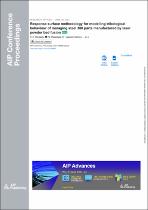 ResearchSpace
ResearchSpace
Response surface methodology for modelling tribological behaviour of maraging steel 300 parts manufactured by laser powder bed fusion
JavaScript is disabled for your browser. Some features of this site may not work without it.
- ResearchSpace
- →
- Research Publications/Outputs
- →
- Journal Articles
- →
- View Item
| dc.contributor.author |
Maodzeka, DK

|
|
| dc.contributor.author |
Mosalagae, M

|
|
| dc.contributor.author |
Hagedorn-Hansen, D

|
|
| dc.contributor.author |
Pityana, Sisa L

|
|
| dc.contributor.author |
Olakanmi, EO

|
|
| dc.date.accessioned | 2024-01-11T09:04:13Z | |
| dc.date.available | 2024-01-11T09:04:13Z | |
| dc.date.issued | 2023-06 | |
| dc.identifier.citation | Maodzeka, D., Mosalagae, M., Hagedorn-Hansen, D., Pityana, S.L. & Olakanmi, E. 2023. Response surface methodology for modelling tribological behaviour of maraging steel 300 parts manufactured by laser powder bed fusion. http://hdl.handle.net/10204/13500 . | en_ZA |
| dc.identifier.isbn | 978-0-7354-4455-3 | |
| dc.identifier.uri | https://doi.org/10.1063/5.0126287 | |
| dc.identifier.uri | http://hdl.handle.net/10204/13500 | |
| dc.description.abstract | Knowledge of friction properties of a material is essential in order to understand its tribological applications. The friction is an important aspect that affects functionality of maraging steel components manufactured by laser powder bed fusion (LPBF). Although friction and wear reduces stability and reliability of vulnerable parts, the friction is beneficial in other applications. A response surface methodology (RSM) model was developed in order to predict and optimise the coefficient of friction (COF) of LPBF manufactured maraging steel 300 parts. The model data was obtained from a series of experiments by varying the following LPBF processing variables; laser power, scan speed and hatch spacing. The RSM model results were consistent with the experiment values. A minimum COF value = 0.109 was predicted under LPBF processing parameters laser power = 130W, scanning speed = 750mm/s and hatch spacing = 104µm. Maximum COF = 0.166 was obtained at laser power = 130, scanning speed = 400mm/s and hatch spacing = 110µm. | en_US |
| dc.format | Fulltext | en_US |
| dc.language.iso | en | en_US |
| dc.relation.uri | https://pubs.aip.org/aip/acp/article-abstract/2581/1/030008/2894180/Response-surface-methodology-for-modelling?redirectedFrom=PDF | en_US |
| dc.source | Proceedings of the 3rd International Conference on Engineering Facilities Maintenance and Management Technologies (EFM2T’21), June 2023 | en_US |
| dc.subject | Coefficient of Friction | en_US |
| dc.subject | Laser powder bed fusion | en_US |
| dc.subject | Maraging Steel 300 | en_US |
| dc.subject | Optimisation | en_US |
| dc.subject | Response surface methodology | en_US |
| dc.title | Response surface methodology for modelling tribological behaviour of maraging steel 300 parts manufactured by laser powder bed fusion | en_US |
| dc.type | Conference Presentation | en_US |
| dc.description.pages | 9pp | en_US |
| dc.description.note | Paper presented during the 3rd International Conference on Engineering Facilities Maintenance and Management Technologies (EFM2T’21), June 2023. ©2023 Authors. Published by AIP Publishing. | en_US |
| dc.description.cluster | Manufacturing | en_US |
| dc.description.impactarea | Laser Enabled Manufacturing | en_US |
| dc.identifier.apacitation | Maodzeka, D., Mosalagae, M., Hagedorn-Hansen, D., Pityana, S. L., & Olakanmi, E. (2023). Response surface methodology for modelling tribological behaviour of maraging steel 300 parts manufactured by laser powder bed fusion. http://hdl.handle.net/10204/13500 | en_ZA |
| dc.identifier.chicagocitation | Maodzeka, DK, M Mosalagae, D Hagedorn-Hansen, Sisa L Pityana, and EO Olakanmi. "Response surface methodology for modelling tribological behaviour of maraging steel 300 parts manufactured by laser powder bed fusion." <i>Proceedings of the 3rd International Conference on Engineering Facilities Maintenance and Management Technologies (EFM2T’21), June 2023</i> (2023): http://hdl.handle.net/10204/13500 | en_ZA |
| dc.identifier.vancouvercitation | Maodzeka D, Mosalagae M, Hagedorn-Hansen D, Pityana SL, Olakanmi E, Response surface methodology for modelling tribological behaviour of maraging steel 300 parts manufactured by laser powder bed fusion; 2023. http://hdl.handle.net/10204/13500 . | en_ZA |
| dc.identifier.ris | TY - Conference Presentation AU - Maodzeka, DK AU - Mosalagae, M AU - Hagedorn-Hansen, D AU - Pityana, Sisa L AU - Olakanmi, EO AB - Knowledge of friction properties of a material is essential in order to understand its tribological applications. The friction is an important aspect that affects functionality of maraging steel components manufactured by laser powder bed fusion (LPBF). Although friction and wear reduces stability and reliability of vulnerable parts, the friction is beneficial in other applications. A response surface methodology (RSM) model was developed in order to predict and optimise the coefficient of friction (COF) of LPBF manufactured maraging steel 300 parts. The model data was obtained from a series of experiments by varying the following LPBF processing variables; laser power, scan speed and hatch spacing. The RSM model results were consistent with the experiment values. A minimum COF value = 0.109 was predicted under LPBF processing parameters laser power = 130W, scanning speed = 750mm/s and hatch spacing = 104µm. Maximum COF = 0.166 was obtained at laser power = 130, scanning speed = 400mm/s and hatch spacing = 110µm. DA - 2023-06 DB - ResearchSpace DP - CSIR J1 - Proceedings of the 3rd International Conference on Engineering Facilities Maintenance and Management Technologies (EFM2T’21), June 2023 KW - Coefficient of Friction KW - Laser powder bed fusion KW - Maraging Steel 300 KW - Optimisation KW - Response surface methodology LK - https://researchspace.csir.co.za PY - 2023 SM - 978-0-7354-4455-3 T1 - Response surface methodology for modelling tribological behaviour of maraging steel 300 parts manufactured by laser powder bed fusion TI - Response surface methodology for modelling tribological behaviour of maraging steel 300 parts manufactured by laser powder bed fusion UR - http://hdl.handle.net/10204/13500 ER - | en_ZA |
| dc.identifier.worklist | 27339 | en_US |





